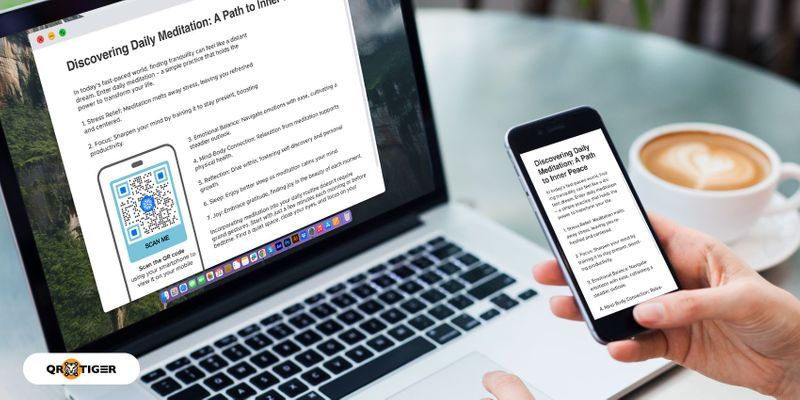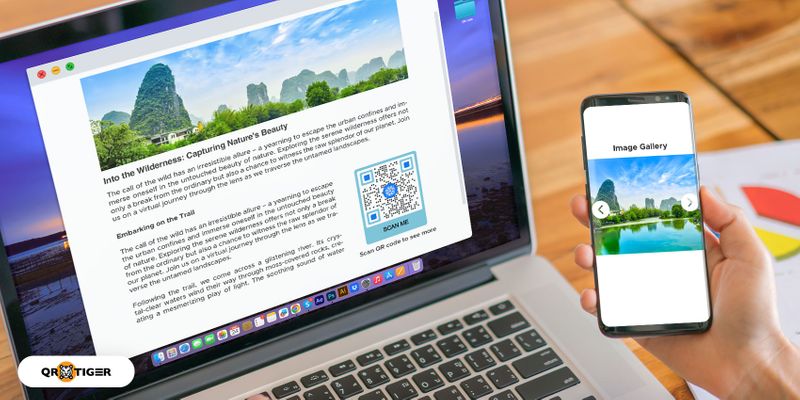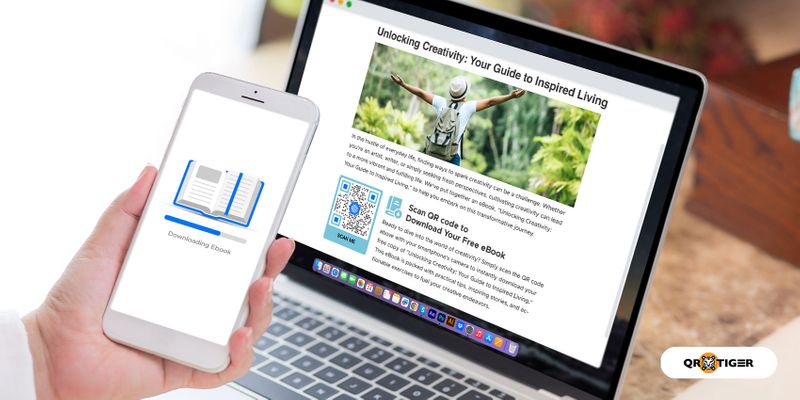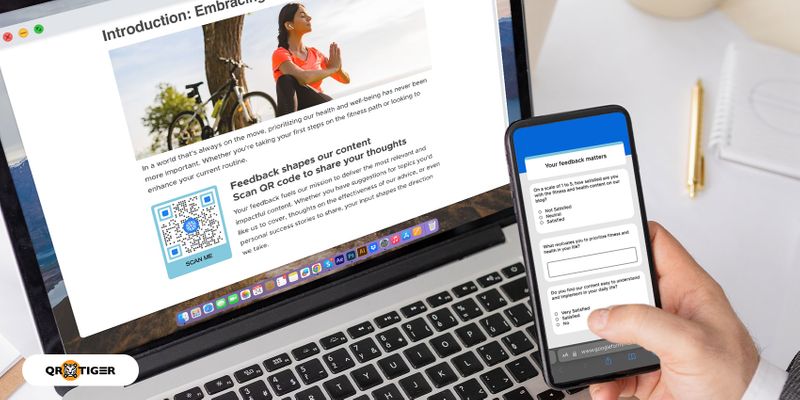How to Create and Put a QR Code on a Blog to Improve Reading Experience

Want to learn how to put a QR code on a blog? You’ve come to the right place!
You can place blog QR codes on your website’s pages so visitors can effortlessly access articles and other resources in just one quick scan.
QR codes are one of the latest and most effective tools in a marketer’s toolkit, and they can be in yours, too. They can significantly boost your online presence and drive traffic to your site.
But before you can place QR codes, you’ll have to create one first. And here’s where a dynamic QR code generator comes in.
With this easy-to-use online software, you’ll have a QR code for your blog in seconds! Learn how to create a QR code and how to place them on your blog in this article.
- 5 Steps to create a QR code for a blog post using a QR code generator
- How to put a QR code on a blog?
- QR code types you can use
- How do I scan a QR code to read an article?
- How blog QR codes can help improve reader experience
- Tips on integrating QR codes in blogs or online articles
- Improve reader experience with QR TIGER
- FAQ
5 Steps to create a QR code for a blog post using a QR code generator
Although QR codes may look complex, they’re extremely easy to make. With the best QR code software, you can customize them and store rich content that elevates the reading experience.
Here’s the easiest way to create a custom QR code for your blog post:
1. Log in to your account on QR TIGER and select a QR code solution.
2. Input the necessary information into the empty field.
3. Select Static QR or Dynamic QR, then click Generate QR code.
Select Dynamic QR so you can edit and track your QR code. This QR code type lets you update the stored information anytime and monitor its performance.
4. Customize your QR code to make it unique. Choose from the customization option for eyes, patterns, frames, and colors. Add a logo and use a frame with a clear call to action (CTA).
5. Test the QR code by scanning it. Then, click PNG or SVG to save it in high-quality image format. Once all is set, hit Download.
Quick tip: Download your QR code in SVG format to resize it with the highest print quality.
After you download the QR code, you can now put it in your blog posts or display it on your website.
Related: Static vs Dynamic QR Code: Their Pros and Cons
How to put a QR code on a blog?
The easiest way is to log into your blogging platform and customize the display settings. But as easy as it may seem, it can vary depending on your platform.
We’ve prepared a quick guide for each of the top blogging websites to show you can add a QR code to your blog on these platforms.
How to add a QR code on a blog post on Blogger
1. Go to Blogger and log in to your account.
2. Upload the QR code image on Google Drive or ImgBB. Then, copy the shareable link of the image.
3. Select a blog post and choose a spot for the QR code image placement.
4. Click Insert Image icon and paste the QR code image file link.
5. Click Add Selected to insert the image.
6. Preview and save.
How to add a QR code on a blog post on WordPress
1. Log in to WordPress
2. Go to Media in the left-hand menu to add your QR code image to the media gallery.
3. Click on Add New and upload the QR code image.
4. Choose a spot where you want to insert the QR code.
5. Click Add Media and select the QR code image you uploaded earlier. You can set the image size, alignment, and other display options.
6. Click Insert into post to add your QR code image to your blog post.
7. Preview and publish your blog.
How to add a QR code on a blog post on Wix
1. Log in to your account on Wix and select a blog post.
2. Click Media, then Upload Media to add the QR code image on Wix Media Manager.
3. Click on the location in your blog post where you want to insert the image.
4. Click Add and select Image.
5. Preview, save, and publish.
QR code types you can use
You can add many kinds of QR codes to your blog, each with a different purpose. Here they are:
- URL QR code. This solution converts any link to a scannable QR code. You can also use this solution to convert blog posts to QR codes, allowing scanners to read your article on their smartphone.
- Link in Bio QR code. This solution can house all your social media links. You can use this as a faster and more interactive approach for readers to connect with your socials all in one place. Users can like, follow, or subscribe to your platforms in just a quick scan.
- App Stores QR code. If you have an app, this solution makes mobile app promotion easy. It redirects scanners to Google Play Store, App Store, or App Gallery (Huawei App Store). With a quick scan, people can instantly download and install your app.
- Landing page QR code. It lets you create a customized mobile landing page without coding or a website builder. It can store videos and multiple images, which scanners can save on their device.
- vCard QR code. This can store multiple contact information like mobile and telephone numbers, email addresses, social media account links, and websites. This solution can streamline networking and communication.
- Email QR code. A solution that stores your email address, the subject line, and a short message. This QR code makes sending emails faster since entering details is unnecessary.
- MP3 QR code. This solution can store audio files (MP3 and WAV format), which lets scanners listen to a soundtrack on their device. They can download the files, too.
- File QR code. A dynamic solution dedicated to storing various files—PDF, JPEG, PNG, MP4, Excel, and Word formats.
These are just some of the solutions you can use. Explore other QR code types to find the best one according to your goal.
How do I scan a QR code to read an article?
You’ll only need your smartphone or tablet to do this. Just scan the QR code with your device’s camera. But if your device doesn’t have built-in QR scanning features, you can install a QR code scanner app.
Point and align your device over the QR code to decode the information. Once the scanning process is done, the code will instantly redirect you to the blog link address.
How blog QR codes can help improve reader experience
Mobile-friendly blog viewing
QR codes make it easy for your readers to enjoy your blog on their phones. With a simple scan using their smartphone, they can effortlessly view, read, or even listen to your blog using a text to speech reader, providing the most convenient experience.
With this technology, there’s no need to type web addresses. Access to your blog is now much easier and faster.
Increase organic blog traffic
Imagine putting QR codes in various mediums like flyers or social media posts. When you use QR codes for your blog, people can visit without going to a browser.
With this technology, you can promote your blog outside the search engines. People who scan these codes land straight on your blog, driving up your visitor count.
Multimedia integration

You can use an image gallery QR code to direct them to a set of images they can save on their device. There are many QR code solutions you can explore on QR TIGER QR Code Generator. There are also QR codes for videos and podcasts.
When a reader scans a code, it’s like they’re in for a treat of different media that goes along with the blog they’re reading.
Enhanced learning experience
If you’re sharing educational resources, QR codes can be magic. Including them in your blog also creates a new reading experience.
They let you link to extra things like quizzes, charts, and study guides. When you put a QR code on a blog post, readers can learn more without the hassle of looking for additional resources.
Resource promotion

Readers can easily dive into valuable info beyond the blog when they scan the code. They can instantly download and save the files on their smartphones.
Encourage email sign-ups
QR codes can bring your readers to your signup form. You can use them to increase email newsletter sign-ups effectively.
Once they scan the QR code, all they have to do is type in their email. Once done, they’re in the loop for updates, freebies, and the latest news. It’s the most convenient way to stay connected with you.
Feedback and assistance

QR codes can be extremely useful when collecting feedback and improving the overall reader experience.
You can use them to store feedback forms, survey forms, or assistance forms, where your readers are free to share their experiences and suggestions to improve your content and more.
This process can be streamlined using survey software, which simplifies data collection and analysis.
Tips on integrating QR codes in blogs or online articles
1. Choose relevant content for your QR codes
Your QR code’s content fits well with your blog post. This could be helpful downloads, related articles, videos, or discount codes matching the topic.
Also, aligning the QR code content based on your goal and target audience is important. Make sure that the content can help your readers.
The purpose of having them on your blog post is to provide supplementary resources that can help them learn or find solutions the easiest way.
2. Use a reliable QR code generator
Go for a QR code software that’s known for working well, like QR TIGER. This ISO-certified software lets you create fully customized QR codes with a logo.
QR TIGER complies with the highest privacy and security standards to protect users against potential risks.
3. Choose a dynamic QR code
There are two types of QR codes: static and dynamic QR codes. While static ones are permanent, dynamic QR codes are editable and have tracking capabilities.
When you put a QR code on a blog, it’s best to choose dynamic QR codes. You can easily change the stored blog link address to a new one anytime. This way, you can redirect your readers to different blog posts using only one QR code.
It’s a smart move for keeping things fresh and up-to-date without needing new codes every time.
4. Add a clear CTA
Adding a call-to-action (CTA) is a must to encourage people to scan your QR code more.
When you put a QR code on a blog, always put a clear and short message next to the QR code. It tells people what they’ll get when they scan it.
For example, “Scan the QR code for a free ebook” or “Scan to see a video tutorial.” This helps them know what to do.
5. Save QR codes in high-quality
The key to seamless QR code scanning doesn’t just depend on your device; it also relies on the QR code image’s quality. Blurry and low-resolution codes are harder to scan, so avoid them.
It’s also important to check the image format. QR TIGER offers two: PNG and SVG. Both are fine for your blog, but SVG has an edge: You can resize it without affecting its quality.
6. Select a strategic placement
When placing your QR code in blogs, timing is everything.
Do not place the QR code randomly. Place the QR code on spots where your readers need additional information. Make sure these places make it convenient for them to scan your QR code.
Put the QR code where it’s easy to spot and makes sense. You can place it at the end of the post, on the side tabs, or even within the content. Just be sure it doesn’t interrupt the reading flow.
7. Do A/B testing QR code placement and design
Always conduct A/B testing to see which QR code placement is effective. This can help you easily adapt and optimize your approach based on user behavior.
You can try out different spots and designs for your QR code. See which ones work best for your readers.
Play around with the frame, colors, eyes, patterns, and the text around it to find what clicks more with your readers or scanners.
Improve reader experience with QR TIGER
Now that you know how to put a QR code on a blog, it’s high time to integrate them as part of your strategy to boost traffic and engagement.
Improving how readers enjoy your content has become a big deal in this fast-changing digital world. And that’s where QR TIGER steps in—a game-changer that can level up how you connect with your audience.
With QR TIGER, you can offer your readers with new experiences when reading your articles online. Plus, they also help drive traffic to your blogs beyond the help of search engines.
Use QR codes to let your readers experience seamless and coherent reading and learning experiences through your blog.
Start your journey towards a mobile-first strategy with QR TIGER QR Code Generator now.
FAQ
How do I create a QR code for an article online?
Here’s how to create a QR code for a blog article’s link:
Go to a reliable online QR code software like QR TIGER and select the URL QR code solution
Copy the link of the published blog article you want to share and paste it onto the designated field. Once done, generate the QR code.




